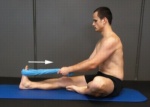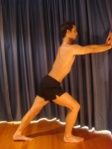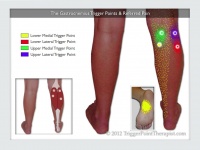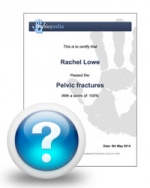Gastrocnemius
Original Editor Aarti Sareen
Top Contributors - George Prudden, Aarti Sareen, Rishika Babburu, Admin, Andeela Hafeez, Kim Jackson, Evan Thomas, Venus Pagare, WikiSysop, Joao Costa, Lucinda hampton, Daphne Jackson and Samuel Adedigba
Description[edit | edit source]
Gastrocnemius forms the major bulk at the back of lower leg and is a very powerful muscle. It is a two joint or biarticular muscle and has two heads and runs from back of knee to the heel. It has a function in any ambulatory movement for example walking, running and jumping. Together with Soleus and Plantaris together forms the calf muscle or triceps surae. Occasionally there are sesamoid bones called "fabella" in the lateral head of gastrocnemius muscle. [1]
Anatomy[edit | edit source]
Origin[edit | edit source]
The two heads are located from the medial and lateral condyles of the femur.
The medial head from behind the medial supercondylar ridge and the adductor tubercle on the popliteal surface of the femur. The lateral head from the outer aspect of the lateral condyle of the femur, just superior and posterior the lateral epicondyle.
Both heads have attachments from the knee joint capsule and from the oblique popliteal ligament.[1]
Insertion[edit | edit source]
The middle 1/3 of the posterior calcaneal surface.
Nerve supply[edit | edit source]
Both heads of the gastrocnemius is supplied by the tibial nerve (S1 and 2). Cutaneous supply is mainly provided by L4, 5 and S2.
Function[edit | edit source]
Powerful plantarflexion at ankle joint.
Flexion at knee joint.
Powefull planterflexor at ankel joint
Flexion at knee joint
As gastrocnemius is strong plantarflexion but enters a stage of passive insufficiency during full dorsiflexion of ankle joint when the knee is near it or in full extension. As the knee flexion increases (soleus become more active). In the seated calf raise (knees flexed to 90º), the gastrocs are virtually inactive while the load is borne almost entirely by the soleus.
The lateral and medial head of gastrocnemius muscle do not involve in the hip rotation but in and MRI study by Dr. Per Tesch (Sweden) suggests "toes in" activate both heads and "toes out" activate the medial head to a higher degree.
Assessment[edit | edit source]
Palpation[edit | edit source]
Power[edit | edit source]
Length[edit | edit source]
Gastrocnemius (outer calf towel stretch): Sit with both legs straight. Loop a towel around the ball of one foot and grasp each end of the towel. Flex your foot back toward your ankle, toes toward your knee. [2]
Begin this calf stretch with your hands against the wall and your leg to be stretched behind you as demonstrated (figure 4). Keep your heel down, knee straight and feet pointing forwards. Gently lunge forwards until you feel a stretch in the back of your calf or knee . Hold for 15 seconds and repeat 4 times at a mild to moderate stretch pain free.[3]
Treatment[edit | edit source]
Trigger Points[edit | edit source]
The gastrocnemius may contain up to four trigger points.
- The two medial trigger points lie in the medial head of the gastrocnemius, with the upper trigger point found just below the crease of the knee, and the lower trigger point an inch or two below it.
- The two lateral trigger points in the lateral head mirror the positioning of the medial trigger points, except that they lie slightly more distal (towards the foot) by about a half-inch.[4]
Resourses[edit | edit source]
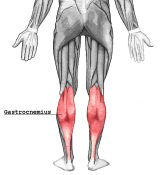
|

|

|
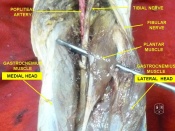
|
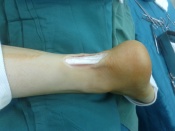
|
See also[edit | edit source]
- Achilles rupture
- Achilles tendinopathy
- Achilles tendon
- Baker's cyst
- Calcaneal fracture
- Calf strain
- Deep vein thrombosis
- Fabella syndrome
- Thompson test
- Soleus
Read 4 Credit[edit | edit source]
|
Would you like to earn certification to prove your knowledge on this topic? All you need to do is pass the quiz relating to this page in the Physiopedia member area. |
Recent Related Research (from Pubmed)[edit | edit source]
References[edit | edit source]
- ↑ 1.0 1.1 Palastanga N, Soames R. Anatomy and Human Movement: Structure and Function. 6th ed. London, United Kingdom: Churchill Livingstone; 2012.
- ↑ http://www.runnersworld.com/stretching/how-stretch-your-calf-muscles
- ↑ http://www.physioadvisor.com.au/8275450/calf-stretches-calf-stretch-calf-flexibility-e.htm
- ↑ http://www.triggerpointtherapist.com/blog/gastrocnemius-pain/gastrocnemius-trigger-points-calf-cramp/

